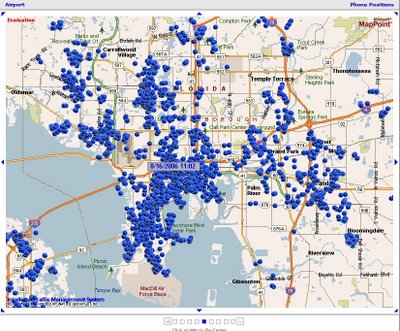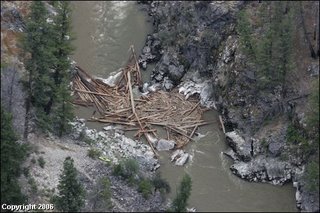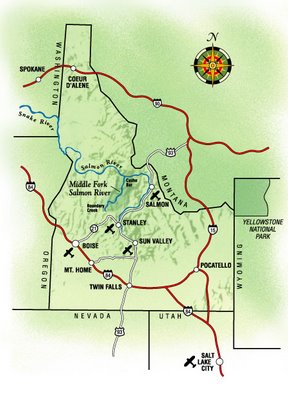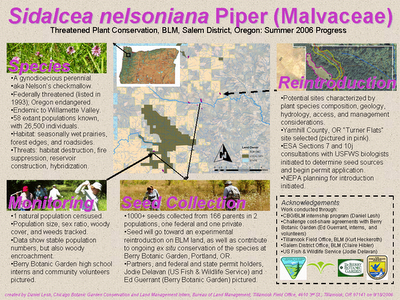So far, I have conducted a quick survey of people on the bus from Santiago and amoung the youngsters that I've met through my friends in Concepcion (one has been here for 7 months). Almost to a person, when I bring up Robinson Carusoe Island I get an excited response about how unique the flora is there and how important a place it is. Of course, they are right: it has by some estimates the most unique flora in all of planet Earth, with 70% of species endemic. Hearing this articulated by 21 year old teaching students is pretty cool.
Another cool find: super nasturiums growing as weeds alongside the soccer field.
Update: It's Robinson Crusoe Island, not Robinson Carusoe Island.
Monday, October 09, 2006
Friday, September 29, 2006
Monday, September 25, 2006
From your phone to your phone traffic data

An NSF funded project that I ran across, using anonymous cell phone location data to show real-time traffic details. It is always reassuring that somebody is thinking creatively out there. Even if is solves problems that control ubran sprawl, there are climate change, not to mention mental health, benefits to reducing traffic congestion.
Photo credit: IntelliOne Technologies Corporation
Sunday, August 27, 2006
Pig N Fords

Here is how the official website describes this year's 81st annual Pig N Ford races at the Tillamook County Fair:
Saturday World Championships
1. Bobby Wasmer
2. Marty Walker
3. Chris Hurliman
4. John Haertel
5. Ben Salo (DQ)
"Bobby had a great start and was able to jump to the early lead and never look back. Marty stayed close throughout the race trying to find an opening. John had some starting troubles, which gave Chris the opening to get the final trophy position. Ben decided to have a little fun while he was in the back of the pack and skip an exchange for fun. The crowd loved it and was able to finish third without the final exchange, but skipping the last exchange is against the rules."
Indeed it was an exciting event, made especially entertaining, as they describe, when Ben skipped the third exchange after trouble with the hand cranking during the second exchange put him out of reach of winning.
Wait. . . What about the fact that the sport entails grabbing a screaming piglet under the arm and racing around a horsetrack in a working model T Ford? After 81 years of Pig n Fords, Tillamook County has, believe it or not, made this ritual normal, and non-ironic, within its borders. I'd guess 5,000 people came from around Oregon to see this feat.
After the race, at which PETA was completely absent (It is easy to think the race is cruel to the pigs, but it is nothing compared to the feedlots they were born in), the pigs get auctioned off. My local natural meat provider, Lance, bought six and is fattening them up right now. They will be ready for purchase in late November or December.
Tuesday, August 22, 2006
Mini Watsa's response to my Slime Mold inquiry
Hey,
Thanks for those pictures! I really have never seen anything quite like it... the sime mould I worked with was of a different order and species than these are. All slime moulds come under the class Mycetozoa. Listed below are the different orders and families.
Protostelia
Protosteliida
Myxogastria
Liceida
Echinosteliida
Trichiida
Stemonitida
Physarida
Dictyostelia
Dictyosteliida
I worked with Dictyostelium, and largely laboratory strains that never formed huge masses that your slime moulds (if I may call them that) do.
I believe that the kind you were looking at belong to the order Myxogastria. They are true slime moulds or plamodial slime moulds where cell membranes are missing. These 'cells' just clump together to form these huge feeding stages called plasmodia (exactly what u saw!) that are quite fascinating. Dictyostelia are cellular slime moulds and form much smaller feeding stages.
Your kind actuallym move at the rate of a mm per hour but can go as fast as 2 cm per minute. They just engulf all kinds of organic matter in their paths.
So, in answer to your question, no, these don't look like what I worked with. Mine required a microscope to be viewed. These are fascinating...you should see if you can look at a bunch under a microscope...see the individual spores perhaps.. or just starve a glob of it and watch the spores form. WOnder what they'll look like then...
Thanks for those pictures! I really have never seen anything quite like it... the sime mould I worked with was of a different order and species than these are. All slime moulds come under the class Mycetozoa. Listed below are the different orders and families.
Protostelia
Protosteliida
Myxogastria
Liceida
Echinosteliida
Trichiida
Stemonitida
Physarida
Dictyostelia
Dictyosteliida
I worked with Dictyostelium, and largely laboratory strains that never formed huge masses that your slime moulds (if I may call them that) do.
I believe that the kind you were looking at belong to the order Myxogastria. They are true slime moulds or plamodial slime moulds where cell membranes are missing. These 'cells' just clump together to form these huge feeding stages called plasmodia (exactly what u saw!) that are quite fascinating. Dictyostelia are cellular slime moulds and form much smaller feeding stages.
Your kind actuallym move at the rate of a mm per hour but can go as fast as 2 cm per minute. They just engulf all kinds of organic matter in their paths.
So, in answer to your question, no, these don't look like what I worked with. Mine required a microscope to be viewed. These are fascinating...you should see if you can look at a bunch under a microscope...see the individual spores perhaps.. or just starve a glob of it and watch the spores form. WOnder what they'll look like then...
Friday, July 28, 2006
Almost Got Stuck

I just returned from 8 days rafting in the Idaho wilderness. Swimming ten times a day in a wild, cool river to get out of the heat, learning to navigate a raft through rapids, and enjoying great company and great views. It all kept me busy and happy.
On our last day we noticed the river was full of sediment. It turned out that rafters mere days behind us on the Middle Fork were stuck by a surprise landslide that sent dozens of trees in the river, blocking the way. It was well reported by The Idaho Statemen, a Boise newspaper. Check out their articles for pictures, movies, and details.
Sunday, July 16, 2006
Middle Fork of the Salmon River

For the next eight days, I will be on a three-person raft floating down the Middle Fork of the Salmon River in central Idaho with 12 Idahoans. This flows north from Stanley, ID through the Frank Church-River of No Return Wilderness, the second largest wilderness area in the lower 48s, to the main branch of the Salmon. The Salmon flows into the Snake near the western edge of Idaho, and eventually into the Columbia just East of the Gorge.
My hosts with be the Marvels. Johanna is an old friend from Grinnell, Adam is her older brother and lives and acts in London, Jon is her father, a retired architect who runs the Western Watersheds Project, and Stephanie is her mother. They have rafted this river together more than 8 times.
Look forward to sharing some photos and maybe a plant or bird list when I get back.
Friday, July 14, 2006
Molly and Noah's Wedding
Concopia, Wisconsin. June 25th.
Boat tour through the Apostle Islands, wiffle ball on the beach, raising the huppa, meeting Noah's high school friends, and listening to the two best wedding toasts. And, of course, a powerfully genuine and personal Jewish wedding of two of my closest friends.
Boat tour through the Apostle Islands, wiffle ball on the beach, raising the huppa, meeting Noah's high school friends, and listening to the two best wedding toasts. And, of course, a powerfully genuine and personal Jewish wedding of two of my closest friends.
Saturday, June 17, 2006
Carbonate Mountain Still Life
This photo is from Hailey, Idaho on Memorial Day. I stopped there on my drive from Kansas to Oregon, where I now live. Idaho has some big country, especially impressive when the wildflowers are getting their groove on. My host in Hailey was Jon Marvel, executive director of the Western Watersheds Project, which at any given time has several lawsuits against BLM in the works. I now work for BLM as a botanist. We had some good conversations about the mythology of the american west and the reasons for BLM's inept management style. On my drive, I also visited with old friends from Alaska: Gretel Haight and family in Longmont, Colorado and Alison Higdon and family in Hailey--great people who are thankfully bringing more great people into the world.
Friday, May 19, 2006
Lemesiur's Yeast
I spent some time on Lemesiur Island with friends Bob, Hank, and LInnea last week. Since then I have been mulling over a few great quotes, which are sitting in me like yeast. If I remember right Mr. Lemesiur was a chef on Vancouver's expedition to Southeast Alaska. Here, it seems, is his recipe for young men trying to find a niche and a right livelihood:
"Conservation as we know it is not an adequate response to an economy that is inherently wasteful and destructive"
- Wendell Berry, "Hell no. Of course not. but . . . " Arctic Refuge: A Circle of Testimony. Edited by Hank Lenfer and Carolyn Servid
"The more I understand hope, the more I realize that all along it deserved to be in [Pandora's] box with the plagues, sorrow, and mischief; that it serves the needs of those in power as surely as belief in a distant heaven; that hope is really nothing more than a secular way of keeping us in line."
- Derrick Jensen, "Beyond Hope" Orion May/June 2006.
"Conservation as we know it is not an adequate response to an economy that is inherently wasteful and destructive"
- Wendell Berry, "Hell no. Of course not. but . . . " Arctic Refuge: A Circle of Testimony. Edited by Hank Lenfer and Carolyn Servid
"The more I understand hope, the more I realize that all along it deserved to be in [Pandora's] box with the plagues, sorrow, and mischief; that it serves the needs of those in power as surely as belief in a distant heaven; that hope is really nothing more than a secular way of keeping us in line."
- Derrick Jensen, "Beyond Hope" Orion May/June 2006.
Tuesday, May 09, 2006
Falls Creek Hydro Project Underway
As Greg Streveler (pictured on left) said yesterday, "[Gustavus] wanted a bit of the outside world, and we got it."
The Falls Creek Hydroelectric Project has been approved and construction in in full swing. The picture is of the road to Falls Creek which is now under construction.
To those of you who don't know, this project is being done on Glacier Bay National Park land (and wilderness designated land at that). Bob Christenson (pictured on right) is in charge of environmental compliance for the project.
To get a sense of why this project is happening, read this short article in the Alaska Journal of Commerce. Notice the complete lack of reference to the environmental impacts of this project, and the haughty impatience for a project with very dubious environmental and economic benefits.
The Falls Creek Hydroelectric Project has been approved and construction in in full swing. The picture is of the road to Falls Creek which is now under construction.
To those of you who don't know, this project is being done on Glacier Bay National Park land (and wilderness designated land at that). Bob Christenson (pictured on right) is in charge of environmental compliance for the project.
To get a sense of why this project is happening, read this short article in the Alaska Journal of Commerce. Notice the complete lack of reference to the environmental impacts of this project, and the haughty impatience for a project with very dubious environmental and economic benefits.
Saturday, May 06, 2006
Dan's Best of Iowa Part 3: Prairie Reconstruction
Tallgrass prairie once spread throughout central North America, as did bear, elk, bison, and prairie wolf. In Iowa, 99.9% of this ecosystem has been lost to the plow--one of the most drastic and widespread landscape changes in human history. Over 95% of Iowa is now privately owned (the second highest percentage in the nation), the vast majority of which is corn and soybeans destined for consumption by hogs, chickens, and cows in massive confinment feeding operations.
Out of this monumental change has grown an equally unique response. Iowans have come to know, like almost no one else, that it is too late to save many of our "last great places", the call of the Nature Conservancy. Indeed, it is the truly greatest, most unbelievably rich places that disappear first. Such as Iowa.
We can protect Iowa's remaining postage stamp remnant prairies and savannas, but reconstruction is the primary tool for recreating vast swaths of flatland prairie, the kind that you can get lost in, along with a herd of bison. These are the places that will have the power and saliency to truly bring Iowa back to its rightful place as one of America's natural treasures and to finally sink the nail into the coffin of the pessimistic and simplistic idea of ecological sacrifice.
The best example of this kind of restoration is the Neil Smith National Wildlife Refuge just east of Des Moines. At 8,000 acres and only 15 years, it is one of the most ambitious restoration projects ever, though by no means is it finished.
For now, however, many of the smaller reconstructions that dot the rest of Iowa are more beautiful and diverse. They have given many, many contemplative Iowans a chance to commune with their degraded landscape, and to try to revive it with their attention and intention. For me, prairie restoration has been one of the most hopeful and spiritually salubrious activities I have ever participated in. It has given me a chance to see how Iowans tick and to share in their long vision for the future of this most contentious landscape.
For more information, watch the trailer of the great documentary America's Lost Landscape: The Tallgrass Prairie.
Out of this monumental change has grown an equally unique response. Iowans have come to know, like almost no one else, that it is too late to save many of our "last great places", the call of the Nature Conservancy. Indeed, it is the truly greatest, most unbelievably rich places that disappear first. Such as Iowa.
We can protect Iowa's remaining postage stamp remnant prairies and savannas, but reconstruction is the primary tool for recreating vast swaths of flatland prairie, the kind that you can get lost in, along with a herd of bison. These are the places that will have the power and saliency to truly bring Iowa back to its rightful place as one of America's natural treasures and to finally sink the nail into the coffin of the pessimistic and simplistic idea of ecological sacrifice.
The best example of this kind of restoration is the Neil Smith National Wildlife Refuge just east of Des Moines. At 8,000 acres and only 15 years, it is one of the most ambitious restoration projects ever, though by no means is it finished.
For now, however, many of the smaller reconstructions that dot the rest of Iowa are more beautiful and diverse. They have given many, many contemplative Iowans a chance to commune with their degraded landscape, and to try to revive it with their attention and intention. For me, prairie restoration has been one of the most hopeful and spiritually salubrious activities I have ever participated in. It has given me a chance to see how Iowans tick and to share in their long vision for the future of this most contentious landscape.
For more information, watch the trailer of the great documentary America's Lost Landscape: The Tallgrass Prairie.
Wednesday, April 26, 2006
Dan's Best of Iowa Part 2: Aesthetics of Loss
David Ottenstein has taken some beautiful photos of Iowa barns and buildings. He visited Grinnell last Fall and I got a chance to talk to him about what he called "the aesthetics of loss". His term strikes at one of the fascinating paradoxes of living in Iowa: our decaying history surrounds us, and at times it is stunningly beautiful. Iowans seem to bear this loss stoically, almost as if it were an extension of their self-effacing, no frills nature. In Ottenstien's photographs the connection between Iowan art, environment, and psychology begs to be discussed.
So, I brought these photos up with Arion Thiboumery, a graduate student at Iowa State University focusing on revitalizing Iowa's small meat lockers. His first thoughts: "when I see these photos there is not an "aesthetic of loss" in terms of sadness, but rather of bearing. . . . There is real salvage in knowing what is here, what is left. The withered and cracked, the ruins in the "low spots and hilltops" on the verge of the oblivion, become all the more beautiful, because they have not been lost for good, yet. The rediscovery fills me with dreams and hope. Even if I do not know their exact use or meaning, or any of it at all, the motivation they bring to make new meaning stretches the limits of measure. Dreams have value, and what inspires us to dream in new ways likewise has value."
"To give you an example: the meat lockers project. Meat lockers are living relics of the past, most that have ever been are gone, but they are a viable means for future sustainability through decentralized production. Some of them are downright dirty and need work. Standards of sanitation have greatly improved in recent years. "Lockers," in many places, are conceived of as "that blood-stained shack where my grandma went to get her cow slaughtered." They need a make over. They need to let the past die so they can be reborn."
So, I brought these photos up with Arion Thiboumery, a graduate student at Iowa State University focusing on revitalizing Iowa's small meat lockers. His first thoughts: "when I see these photos there is not an "aesthetic of loss" in terms of sadness, but rather of bearing. . . . There is real salvage in knowing what is here, what is left. The withered and cracked, the ruins in the "low spots and hilltops" on the verge of the oblivion, become all the more beautiful, because they have not been lost for good, yet. The rediscovery fills me with dreams and hope. Even if I do not know their exact use or meaning, or any of it at all, the motivation they bring to make new meaning stretches the limits of measure. Dreams have value, and what inspires us to dream in new ways likewise has value."
"To give you an example: the meat lockers project. Meat lockers are living relics of the past, most that have ever been are gone, but they are a viable means for future sustainability through decentralized production. Some of them are downright dirty and need work. Standards of sanitation have greatly improved in recent years. "Lockers," in many places, are conceived of as "that blood-stained shack where my grandma went to get her cow slaughtered." They need a make over. They need to let the past die so they can be reborn."
Sunday, April 23, 2006
Dan's Best of Iowa Part 1: Golden Ridge Blue Cheese
Iowan blue cheese is synonymous with Maytag. This famous blue, made by the famous kitchen appliance family, has a subtle blue flavor and clean, almost metallic, cow milk finish. But the real story in Iowa is a new comer in the northeast--Golden Ridge Cheese Cooperative's natural rind blue, which, in a mere two years of production, has racked up two major awards: "Best Blue in the US" (2004 American Cheese Society Competition) and second best blue-veined cheese world-wide (2005 Wisconsin Cheese Makers Competition).
The co-op is owned by a group of 40 Amish dairy farmers, who felt their high-quality, hand-milked, organic milk deserved a better market than regional dairies. The USDA and the county helped them purchase a modern factory in 1998 and hire a crew of "English" who run the machines and carry out their traditional French/Spanish-inspired recipe. The key to their success seems to be in the little things: happy cows, a small degree of natural fermentation on the way to the factory, an absense of fat-chain-breaking mechanical pumps in the production line, and a natural, flavorful rind.
The product is a much more layered and intimate cheese than Maytag's self-effacing midwestern product. Subtle enough for non blue cheese fans, but complex enough for its national audience, the Natural Rind Blue (Golden Ridge's award-winner) features a mushroomy taste with layers of rich cream and a light grass-fed tang.
You'll find this cheese in any major American cheese shop, but visit their website and buy via mail at half the price and you'll save money, eat world-class cheese, and support the livelihoods of our country's best environmental stewards -- the Amish.
Even better, make the drive up to the factory. If you make it past the Amish farms in the area (the horse-drawn plows, playing kids and bake sales easily distract), you'll get to visit with the General Manager, Richard, who has also won awards for his organic pecans. Ask him how long the two wheels of cheese you've just bought (at $5 a pound who wouldn't?), and you'll likely get the same answer I did: "In front of me, ten minutes."
The co-op is owned by a group of 40 Amish dairy farmers, who felt their high-quality, hand-milked, organic milk deserved a better market than regional dairies. The USDA and the county helped them purchase a modern factory in 1998 and hire a crew of "English" who run the machines and carry out their traditional French/Spanish-inspired recipe. The key to their success seems to be in the little things: happy cows, a small degree of natural fermentation on the way to the factory, an absense of fat-chain-breaking mechanical pumps in the production line, and a natural, flavorful rind.
The product is a much more layered and intimate cheese than Maytag's self-effacing midwestern product. Subtle enough for non blue cheese fans, but complex enough for its national audience, the Natural Rind Blue (Golden Ridge's award-winner) features a mushroomy taste with layers of rich cream and a light grass-fed tang.
You'll find this cheese in any major American cheese shop, but visit their website and buy via mail at half the price and you'll save money, eat world-class cheese, and support the livelihoods of our country's best environmental stewards -- the Amish.
Even better, make the drive up to the factory. If you make it past the Amish farms in the area (the horse-drawn plows, playing kids and bake sales easily distract), you'll get to visit with the General Manager, Richard, who has also won awards for his organic pecans. Ask him how long the two wheels of cheese you've just bought (at $5 a pound who wouldn't?), and you'll likely get the same answer I did: "In front of me, ten minutes."
Friday, March 24, 2006
My Photos
Photos from my travels in Latin America and the Caribbean, and food and natural history adventures in the US. Check them out at their (now permanent) address: www.flickr.com/photos/danlesh.
Subscribe to:
Posts (Atom)







